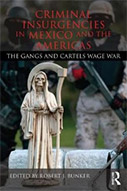Criminal Insurgencies in Mexico and the Americas:
The Gangs and Cartels Wage War
 Editor: Robert J. Bunker
Editor: Robert J. Bunker
Publisher: New York: Routledge/Taylor and Francis, 2013. 210p.
Reviewer: Ami C. Carpenter | July 2013
Criminal Insurgencies in Mexico and the Americas focuses on the phenomenon of violent conflict waged by armed actors involved to varying degrees in criminal enterprises. This edited volume covers a variety of important topics. Its works are conceptually grounded in a view of the emerging global security environment that is characterized by irregular or unconventional actors – whether warlords or druglords – who play major roles in domestic, regional and international security.
The main theses of this volume are that the lines between political and criminal conflict are increasingly blurred; that conventional policing strategies will not suffice to deal with highly networked and often transnational criminal organizations (TCOs); and that states (chiefly the US, the audience for whom this book was written) are not conceptually equipped for dealing with the unconventional threats posed by gangs, ‘cartels,’ and transnational criminal organizations.
Many of the arguments are valid and timely. Chief among them is that TCOs are a category of non-state armed actors that should be taken seriously. Sullivan and Bunker make their case well in Chapter One, pointing out that TCOs are hybrid actors with political and economic agendas whose diversified portfolio of profitmaking activities include narcotics sales, kidnapping, theft, extortion, human trafficking, and more (32).
In Chapter Three, the same authors extend the literature on urban decay and failing communities (the de-institutionalization or “ferality” of social space) by introducing the interesting concept of “re-institutionalization of urban social and political structures” by criminal actors. They argue that in some places, non-state armed actors have assumed governance to a degree that they have reconstituted the political, cultural, social and economic structure of the places they occupy.
Key contributions of other chapters include detailed description of the collusion between Mexican TCOs and the Mexican government (Chapter Four), the debunking of the myth that the majority of firearms in Mexico derive from the United States (Chapter Five), the spread of corruption to US border enforcement (Chapter Six), and in-depth analyses in Chapters Seven and Eight of the causes and country-level dynamics of particular armed groups. All in all, this volume has much to offer in terms of information on a wide range of topics related to the regional operations of TCOs in Mexico and Central America.
Criminal Insurgencies is also a somewhat disjointed volume. Units of analysis range from countries, parts of countries, cities and parts of cities. Authors contradict each other on important points, the most notable of which is dis-census over the overarching construct of the whole book: whether the activities of gangs and TCOs are tantamount to insurgents (e.g. Steven Dudley’s comments in Chapter Eight that tactics used by the Mexican group Los Zetas “have often been confused with that of an insurgency” (181)). Authors vacillate between referring to the country of Mexico as “an entity that is truly the antithesis of the modern nation state” and arguing that zones or cities of Mexico differ on the dimension of ‘state-ness.’ In addition, some authors draw varying distinctions between types of non-state actors, while others conflate such diverse groups as gangs, ‘cartels,’ mafia, terrorists, insurgents and pirates.
Lack of cohesion tends to be a critique of edited volumes in general, and in this case it could have been minimized by (1) clearly positioning the disparate chapters within a rigorous analytical framework (preferably in the Introductory Chapter), and (2) by including a concluding chapter to synthesize key points, lessons, and insights. However, the deeper conceptual problem contributing to the fragmentation of author contributions is the notion of criminal insurgency itself.
‘Criminal insurgency’ is a frame that shapes actors’ understanding of the causes of violence and the role of the intervener, making certain actions possible while precluding others. It derives from a criminal justice lens, as Bunker himself pointed out in a compelling and insightful analysis called The Mexican Cartel Debate: As Viewed Through Five Divergent Fields of Security Studies. The uncritical semantic construction of “criminal insurgency” used in this volume situates actors (‘gangs,’ ‘cartels,’ ‘criminal soldiers,’ ‘criminal gangsters,’ ‘social bandits’) as the cause of state weakness, and not the other way around as Bunker himself proposed in Chapter One:
During periods of epochal change, the old state form institutions increasingly become outmoded…the state begins to fail as a social and political civilization [and] shifts toward regional polities takes place – partially derived from…the inability of a state to alone provide basic public goods for its people.
The origins of power vacuums and underperforming (or weak) states are under-theorized and largely absent in this volume, even though there exists a rather large literature addressing the conditions under which they develop. Too little is said about the reasons for the growth of TCOs in Mexico and the Americas, even though authors agree that narrow law enforcement strategies are not the appropriate level of response, and little is said about the global market forces that underpin transnational organized crime as a phenomenon (not a collection of actors). Max Manwaring’s chapter comes the closest to producing a theoretical explanation of the structural causes of the emergence of TCOs, including poverty, unemployment, lack of upward social mobility, and the domestic political context. Chapter Seven also offers a very useful explanation of the ways in which the “TCO-gang phenomenon” represents specific challenges to the authority and sovereignty of the Mexican government (150).
Complex conflicts involving criminal entities defy conventional analysis – of which the insurgency construct is one – precisely because political and criminal worlds are interpenetrated. Treating conflicts in Mexico and the Americas as a struggle between “criminals” and “governments” would seem to overlook the fact that governmental actors are and were complicit for decades in the extent to which transnational criminal organizations have amassed considerable economic and political power. However, in another example of vacillation, this fact is not overlooked – Malcolm Beith’s chapter “A Broken Mexico” does an excellent job of describing the extent to which distinctions between “legal” and “illegal” actors are eroded, with law enforcement (particularly the Municipal Police and Mexico’s Federal Investigative Agency) involved for decades in kidnapping, murder, and other criminal activity.
Criminal Insurgencies in Mexico and the Americas is worth the read; it provides a rich, case-based description of the breadth and depth to which transnational criminal organizations have penetrated societies in the Americas. Where it falls short is perhaps where most analyses of “epochal change and new realities” fall short; coming to grips with the tremendous challenges for regulating illicit trade presented by the nature of global flows coupled with the largely state-based crime control strategies.
Ami C. Carpenter, Ph.D., is an assistant professor at the Joan B. Kroc School of Peace Studies at the University of San Diego.


